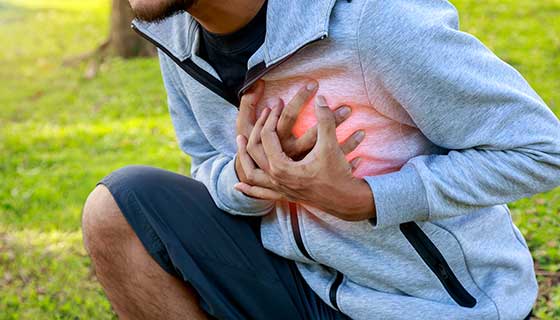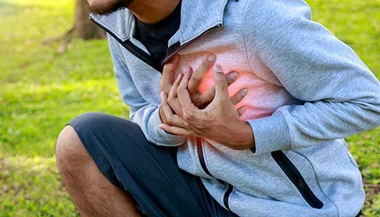Coronary Heart Disease
What are the coronary arteries?
Coronary arteries supply blood to the heart muscle. Like all other tissues in the body, the heart muscle needs oxygen-rich blood to function, and oxygen-depleted blood must be carried away. The coronary arteries run along the outside of the heart and have small branches that supply blood to the heart muscle.
What are the different coronary arteries?
The 2 main coronary arteries are the left main and right coronary arteries.
-
Left main coronary artery (LMCA). The left main coronary artery supplies blood to the left side of the heart muscle (the left ventricle and left atrium). The left main coronary artery divides into branches:
-
The left anterior descending artery branches off the left coronary artery and supplies blood to the front of the left side of the heart.
-
The circumflex artery branches off the left coronary artery and encircles the heart muscle. This artery supplies blood to the lateral side and back of the heart.
-
-
Right coronary artery (RCA). The right coronary artery supplies blood to the right ventricle, the right atrium, and the SA (sinoatrial) and AV (atrioventricular) nodes, which regulate the heart rhythm. The right coronary artery divides into smaller branches, including the right posterior descending artery and the acute marginal artery.
Additional smaller branches of the coronary arteries include the obtuse marginal (OM), septal perforator (SP), and diagonals.
Why are the coronary arteries important?
Since coronary arteries deliver blood to the heart muscle, any coronary artery disorder or disease can reduce the flow of oxygen and nutrients to the heart, which may lead to a heart attack and possibly death. Atherosclerosis is inflammation and a buildup of plaque in the inner lining of an artery causing it to narrow or become blocked. It is the most common cause of heart disease.
What is coronary artery disease?
Coronary heart disease, or coronary artery disease (CAD), is characterized by inflammation and the buildup of and fatty deposits along the innermost layer of the coronary arteries. The fatty deposits may develop in childhood and continue to thicken and enlarge throughout the life span. This thickening, called atherosclerosis, narrows the arteries and can decrease or block the flow of blood to the heart.
The American Heart Association estimates that over 16 million Americans suffer from coronary artery disease--the number one killer of both men and women in the U.S.
What are the risk factors for coronary artery disease?
Risk factors for CAD often include:
-
Smoking
-
High LDL cholesterol, high triglycerides levels, and low HDL cholesterol
-
High blood pressure (hypertension)
-
Physical inactivity
-
Obesity
-
High saturated fat diet
-
Diabetes
-
Family history
Controlling risk factors is the key to preventing illness and death from CAD.
What are the symptoms of coronary artery disease?
The symptoms of coronary heart disease will depend on the severity of the disease. Some people with CAD have no symptoms, some have episodes of mild chest pain or angina, and some have more severe chest pain.
If too little oxygenated blood reaches the heart, a person will experience chest pain called angina. When the blood supply is completely cut off, the result is a heart attack, and the heart muscle begins to die. Some people may have a heart attack and never recognize the symptoms. This is called a "silent" heart attack.
Symptoms of coronary artery disease include:
-
Heaviness, tightness, pressure, or pain in the chest behind the breastbone
-
Pain spreading to the arms, shoulders, jaw, neck, or back
-
Shortness of breath
-
Weakness and fatigue
How is coronary artery disease diagnosed?
In addition to a complete medical history and physical exam, tests for coronary artery disease may include the following:
-
Electrocardiogram (ECG or EKG). This test records the electrical activity of the heart, shows abnormal rhythms (arrhythmias), and detects heart muscle damage.
-
Stress test (also called treadmill or exercise ECG). This test is given while you walk on a treadmill to monitor the heart during exercise. Breathing and blood pressure rates are also monitored. A stress test may be used to detect coronary artery disease, or to determine safe levels of exercise after a heart attack or heart surgery. This can also be done while resting using special medicines that can synthetically place stress on the heart.
-
Cardiac catheterization. With this procedure, a wire is passed into the coronary arteries of the heart and X-rays are taken after a contrast agent is injected into an artery. It's done to locate the narrowing, blockages, and other problems.
-
Nuclear scanning. Radioactive material is injected into a vein and then is observed using a camera as it is taken up by the heart muscle. This indicates the healthy and damaged areas of the heart.
Treatment for coronary heart disease
Treatment may include:
-
Modification of risk factors. Risk factors that you can change include smoking, high cholesterol levels, high blood glucose levels, lack of exercise, poor dietary habits, being overweight, and high blood pressure.
-
Medicines. Medicine that may be used to treat coronary artery disease include:
-
Antiplatelets. These decrease blood clotting. Aspirin, clopidogrel, ticlopidine, and prasugrel are examples of antiplatelets.
-
Antihyperlipidemics. These lower lipids (fats) in the blood, particularly low density lipid (LDL) cholesterol. Statins are a group of cholesterol-lowering medicines, and include simvastatin, atorvastatin, and pravastatin, among others. Bile acid sequestrants--colesevelam, cholestyramine and colestipol--and nicotinic acid (niacin) are other medicines used to reduce cholesterol levels.
-
Antihypertensives. These lower blood pressure. Several different groups of medicines work in different ways to lower blood pressure.
-
-
Coronary angioplasty. With this procedure, a balloon is used to create a bigger opening in the vessel to increase blood flow. Although angioplasty is done in other blood vessels elsewhere in the body, percutaneous coronary intervention (PCI) refers to angioplasty in the coronary arteries to permit more blood flow into the heart. PCI is also called percutaneous transluminal coronary angioplasty (PTCA). There are several types of PCI procedures, including:
-
Balloon angioplasty. A small balloon is inflated inside the blocked artery to open the blocked area.
-
Coronary artery stent. A tiny mesh coil is expanded inside the blocked artery to open the blocked area and is left in place to keep the artery open.
-
Atherectomy. The blocked area inside the artery is cut away by a tiny device on the end of a catheter.
-
Laser angioplasty. A laser used to "vaporize" the blockage in the artery.
-
-
Coronary artery bypass. Most commonly referred to as simply "bypass surgery" or CABG (pronounced "cabbage"), this surgery is often done in people who have chest pain (angina) and coronary artery disease. During the surgery, a bypass is created by grafting a piece of a vein above and below the blocked area of a coronary artery, enabling blood to flow around the blockage. Veins are usually taken from the leg, but arteries from the chest or arm may also be used to create a bypass graft. Sometimes, multiple bypasses may be needed to fully restore blood flow to all regions of the heart.







